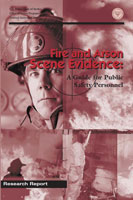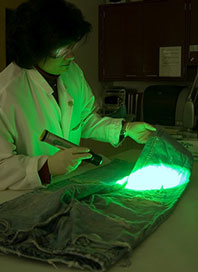|
View in browser: http://www.crime-scene-investigator.net/newsletter/0418.html
|
||
|
APRIL 2018 | ||
| ||
|
This Month's Featured Resource on the Crime Scene Investigator Network Website
|
||
 It is the intention of this Guide to acquaint a broad spectrum of public safety personnel with the fire investigation process, so they may understand their role in this important task and help identify, locate, and preserve evidence in its varied forms, to either assist a specialist investigator when one is needed or to adequately document and collect evidence when no assistance is needed or available. This Guide focuses on the documentation and collection of physical evidence at fire/arson scenes. <View the Publication> |
||
|
New CSI and Forensic Job Announcements
|
||
|
The most comprehensive listing of Crime Scene Investigation and Forensic To be notified of job openings as they are posted, follow us on Twitter: Job Posting Alerts |
||
|
Crime Scene Evidence Technician II, USA
Final Filing Date: May 8, 2018 Responsible for the collection and preservation of evidence in criminal investigations and performing identification services to the public. Also responsible for responding to crime scenes for processing of evidence related to crimes. <View complete job listing> |
||
|
Crime Scene Specialist
Round Rock Police Department, Round Rock, Texas, USA Final Filing Date: June 3, 2018 The Crime Scene Specialist responds to crime scenes and other serious incidents for the purpose of documenting and gathering evidence. <View complete job listing> |
||
|
Forensics Technician
Osceola County Sheriff's Office, Kissimmee, Florida, USA Final Filing Date: Open until filled The Forensic Technician performs technical work in criminal identification matters to include photography, collection and preservation of evidence, processing for latent fingerprints, examining biological substances, and physical documentation of crime scenes. <View complete job listing> |
||
 |
||
|
Criminalist
Los Angeles Police Department, Los Angeles, California, USA Final Filing Date: Continuous A Criminalist searches for, collects and preserves physical evidence in the investigation of crime and suspected criminals; examines evidence by means of physical and chemical analyses; prepares reports of findings; and gives expert testimony in court. At the highest pay grade, performs analyses of physical and chemical evidence of a nonroutine nature requiring advanced technology; and may serve as a lead worker by providing training and supervision to criminalists working in a specialized field. <View complete job listing> |
||
|
Forensic Crime Laboratory Intern
South Bend Police Department, South Bend, Indiana, USA Final Filing Date: Open until filled This internship will consist of processing a variety of evidence including vehicles, DNA, fingerprints, and various items collected from crime scenes. <View complete job listing> |
||
|
Latent Print Examiner
Chula Vista Police Department, Chula Vista, California, USA Final Filing Date: May 7, 2018 To perform a variety of complex tasks in the identification, classification, automation and comparison of latent prints in connection with the investigation of crimes; prepare presentation of evidence for court and serve as an expert on all phases of latent print identification; and to perform other related duties as assigned. <View complete job listing> |
||
|
Search for more job listings in Crime Scene Investigations and Forensics To be notified of job openings as they are posted, follow us on Twitter: Job Posting Alerts |
||
|
Other Resources on the Crime Scene Investigator Network Website
|
||
|
Crime Scene Investigator mdash; Blog
Crime Scene Investigator Forum How to Become a Crime Scene Investigator Crime Scene Response Evidence Collection Crime Scene and Evidence Photography Crime Scene Investigation Articles Video Presentations College and University Programs Employment Resources and Links |
||
|
Not Subscribed to this Newsletter?
|
||
|
If you are not subscribed to this newsletter, you may subscribe with this link: SUBSCRIBE via email |
||
|
To Unsubscribe
|
||
|
To unsubscribe from future e-mail newsletters, please click here: UNSUBSCRIBE Copyright ©2018 Crime Scene Resources, Inc. Crime Scene Investigator Network |

 The "Mounties" pioneered the use of argon-ion lasers, but these expensive, cumbersome, bulky machines were impractical for use at crime scenes, so their use was limited to the crime lab.
The "Mounties" pioneered the use of argon-ion lasers, but these expensive, cumbersome, bulky machines were impractical for use at crime scenes, so their use was limited to the crime lab.
